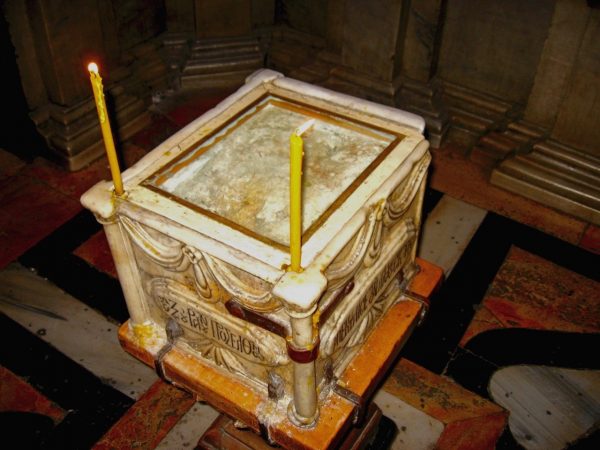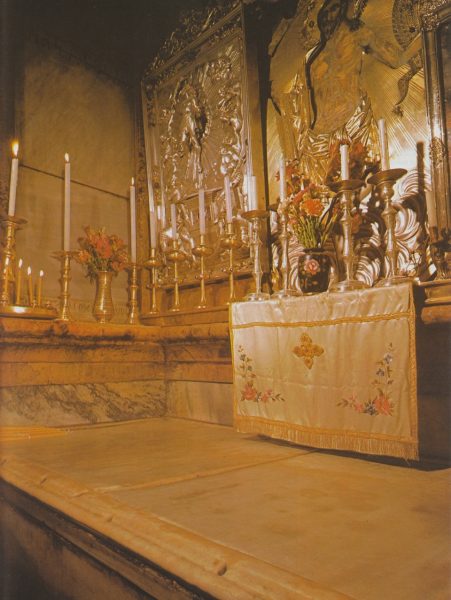He is not here; He has risen! –Luke 24:6
Beneath the larger of the two domes of the Church of the Holy Sepulcher is a rotunda known as the Anastasis, a Greek word meaning resurrection.
In the center of the Anastasis is a chapel called the Aedicule, which contains two rooms. The first room enshrines the Angel’s Stone, believed to be a fragment of the large rock that sealed the tomb of Christ.
The second room contains the tomb itself, which originally would have consisted of two chambers connected by a low door: a larger outer chamber where the mourners gathered, and a smaller inner cell where the body was laid on a stone ledge. The original ledge is now covered by a marble slab.
An earlier chapter described the discovery of this tomb in 325 AD beneath a Roman temple of Venus. Sadly, the actual rock-cut tomb was destroyed by the mad Caliph al-Hakim in 1009, who razed it down to the bedrock. Only fallen rubble saved the actual burial ledge. Nevertheless, a good idea of the tomb’s appearance can be gathered from another multi-chambered cave tomb just a few yards away, which also indisputably dates from the first century. The proximity of these other tombs strongly suggests that the entire complex was the family sepulcher of the wealthy Joseph of Arimathea, who asked Pilate for the body of Jesus and interred it in one of his own chambers.
Today the Tomb of Christ is administered by several denominations, all of whom daily celebrate therein the Divine Liturgy or Holy Mass. But one service is of particular interest: the Miracle of Holy Fire observed on the Orthodox date of Easter. This miraculous appearance of fire has taken place in the same manner every year for two thousand years. Written accounts from the fourth century by Gregory of Nyssa and John of Damascus relate how the Apostle Peter saw the Holy Fire in the Holy Sepulcher after Christ’s resurrection. According to an Orthodox source, “No other miracle is known to occur so regularly and so steadily over time.” Listen to an account of the Miracle of Holy Fire by the Orthodox Patriarch of Jerusalem, Diodor, who has witnessed it sixteen times:
“Finding my way through the darkness towards the inner chamber, I enter the tomb and kneel in holy fear in front of the place where Christ lay after His death and where He rose again from the dead. Here I say certain prayers that have been handed down to us through centuries and, having said them, I wait. Sometimes I may wait a few minutes, but normally the miracle happens immediately after I have said the prayers. From the core of the very stone on which Jesus lay an indefinable light pours forth. It usually has a blue tint, but the color may change and take many different hues. It cannot be described in human terms. The light rises out of the stone as mist may rise out of a lake—it almost looks as if the stone is covered by a moist cloud, but it is light. This light each year behaves differently. Sometimes it covers just the stone, while other times it gives light to the whole sepulcher, so that people who stand outside the tomb and look into it will see it filled with light. The light does not burn…. It is of a different consistency than normal fire that burns in an oil lamp…. At a certain point the light rises and forms a column in which the fire is of a different nature, so that I am able to light my candles from it. When I have thus received the flame on my candles, I go out and give the fire first to the Armenian Patriarch and then to the Coptic. Hereafter I give the flame to all people present in the church.”
How interesting that this miracle is not more widely acknowledged. But then, the same might be said of the resurrection, which has been called the best-attested fact of ancient history.
Photo #1: Adriatikus. “The Angel’s Stone.” 2008. Wikimedia Commons. Wikipedia.org.
Photo #2: Mike Mason
Next Week: The Garden Tomb


